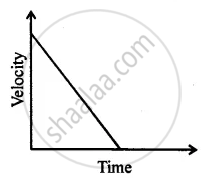Advertisements
Advertisements
Question
A packet is dropped from a stationary helicopter, hovering at a height ‘h’ from ground level, reaches the ground in 12s. Calculate
- the value of h
- final velocity of packet on reaching the ground. (Take g = 9.8 ms−2)
Solution
Height of the helicopter = h =?
Initial velocity = u = 0
Time = t = 12s
Acceleration = a = + g = + 9.8 ms−2
(1) S = ut + `1/2` at2
h = `0(12)+1/2(9.8)(12)^2`
h = 0 + 4.9 (144)
h = 705.6 m
(2) Let v = velocity of the packet on reaching the ground.
v = u + at
v = 0 + (9.8) 12
v = 117.6 ms−1
APPEARS IN
RELATED QUESTIONS
A bus decreases its speed from 80 km h−1 to 60 km h−1 in 5 s. Find the acceleration of the bus.
Which of the two can be zero under certain conditions : average speed of a moving body or average velocity of a moving body ?
Fill in the following blank with suitable word :
A motorcycle has a steady……………. of 3 m/s2. This means that every………………. its…………….. increases by………….
Name the quantity which is measured by the area occupied under the velocity-time graph.
A bus running at a speed of 18 km/h is stopped in 2.5 seconds by applying brakes. Calculate the retardation produced.
The figure shows the displacement - time graph for four bodies A, B C and D. In each case state what information do you get about the acceleration (zero, positive or negative).

For a uniformly retarded motion, the velocity-time graph is _____________
Derive the following equations for uniformly accelerated motion:
(i) v = u + at
(ii) `"S = ut" + 1/2 "at"^2`
(iii) v2 = u2 + 2aS
where the symbols have their usual meanings.
When is the negative acceleration?
Can you suggest a real-life example about the motion of a body from the following velocity – time graph?

